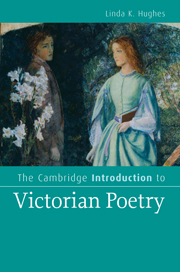Book contents
- Frontmatter
- Contents
- List of figures
- Preface
- Acknowledgments
- Editions cited
- Introducing Victorian poetry
- Part I The forms of Victorian poetry
- 1 Victorian experimentalism
- 2 Victorian dialogues with poetic tradition
- 3 The impress of print: poems, periodicals, novels
- Part II The rhetoric of Victorian poetry
- Part III Coda Close readings
- Glossary
- Notes
- Further reading
- Index
- Cambridge Introductions to Literature
3 - The impress of print: poems, periodicals, novels
Published online by Cambridge University Press: 05 June 2012
- Frontmatter
- Contents
- List of figures
- Preface
- Acknowledgments
- Editions cited
- Introducing Victorian poetry
- Part I The forms of Victorian poetry
- 1 Victorian experimentalism
- 2 Victorian dialogues with poetic tradition
- 3 The impress of print: poems, periodicals, novels
- Part II The rhetoric of Victorian poetry
- Part III Coda Close readings
- Glossary
- Notes
- Further reading
- Index
- Cambridge Introductions to Literature
Summary
Our chain on silence clanks.
Time leers between, above his twiddling thumbs.
Am I quite well? Most excellent in health!
The journals, too, I diligently peruse.
Vesuvius is expected to give news:
Niagara is no noisier. By stealth
Our eyes dart scrutinizing snakes.
George Meredith, Modern Love (1862)We talked modern books
And daily papers, Spanish marriage-schemes
And English climate – was't so cold last year?
And will the wind change by to-morrow morn?
Can Guizot stand? is London full? is trade
Competitive? has Dickens turned his hinge
A-pinch upon the fingers of the great?
Elizabeth Barrett Browning, Aurora Leigh (1856)In Modern Love and Aurora Leigh periodicals and contemporary fiction are commonplace features of a quotidian world within which modern erotic relationships unfold. Poetry, too, as prior chapters indicate, routinely appeared in newspapers and magazines, where it was read alongside fiction, news, and other prose forms. If Aurora Leigh cites Dickens and draws on Jane Eyre for its plot, novelists likewise incorporated contemporary poetry into their creations, suggesting why it is important to look at these multiple print forms together.
Two of the most widely anthologized Victorian theories of poetry today are “On Some of the Characteristics of Modern Poetry,” by Arthur Henry Hallam, first published in Englishman's Magazine (August, 1831), and “What is Poetry?” by John Stuart Mill, published under the pseudonym “Antiquus” in the Monthly Repository (January, 1833).
- Type
- Chapter
- Information
- The Cambridge Introduction to Victorian Poetry , pp. 89 - 110Publisher: Cambridge University PressPrint publication year: 2010

